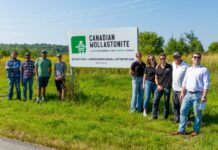by Jason Byvelds,
Proud Canadian Farmer
You shouldn’t be disappointed, Colin Creasey, that the letter to the editor you submitted on December 4 didn’t resonate with me, nor did the parts from Vanessa Baird’s article What If…The World Turned Vegan, but I did enjoy the irony of the one on January 8. It is important that when you quote other sources, you choose factual versus opinion. Perhaps it’s your choice of sources that fuels your skepticism of one of the safest food systems in the world.
First, your primary point that 68% of cropland being used for animal feed is incorrect; the FAO estimates that 33% of land globally is used to grow crops for animals. According to Statistics Canada and US census data, your 68% of cropland used for feeding animals is not reflected in either country’s data–and both countries are net exporters. This also highlights that you do not understand the difference between pasture and cropland, or maybe the role animals play in the food waste pyramid, or that organic agriculture is based on animal inputs. The simplest example I can give you for pasture is when beef farmers in Saskatchewan graze their cattle on Grasslands National Park, you can’t just plow grassland under and try to grow crops and pretend it’s more sustainable or better for the environment. Or, if you’re looking for something local, the next time you drive on Shanly Road you will see marginal land that can’t support crops being used to graze beef cattle.
You have also noted that 70% of the world’s food is grown by small scale farmers, the full statistic is farms that are 25 acres or less. This statistic is skewed because in countries like India where there is 118.7 million farm operators and 144.3 million farm laborers. Canada has 271,935 farm operators according to the 2016 census. More than a third of the world’s malnourished children live in India, and the average farmer in India makes around $2,276 Cdn per year, whereas the majority of Canadian farmers are college or university educated and use GPS-guided equipment. The 25-acre limit example you chose excludes pretty much every farm and farmer here in Canada, as when settlers came they were given 100 acre parcels, 160 acres or quarters as they moved out west.
You are excluding the majority of Canadian farmers from your vision as well as non-organic farmers because of your skepticism. Instead, you need to address or ask why we make the decisions that we do and why we have one of the safest food systems in the world. You are also advocating undoing the Green Revolution because of your beliefs not science, for example if the regulations I referred you to for organic agriculture was based on sustainability and science, it wouldn’t arbitrarily ban synthetic nitrogen simply because it’s synthetic, or breeding technologies like CRISPR.
Colin, you live in a community that is surrounded by the agriculture sector. It was home to the Kemptville Agricultural College for 97 years (a college where the teachings revolutionized agriculture in Eastern Ontario), there are offices for both OMAFRA and the Ministry of Natural Resources, and you are surrounded by farmers many of which are alumni—there are plenty of resources to ask or learn from if you do have questions.
I would prefer to write about how Canadian farmers are doing their part to help combat climate change everyday and receive almost no political or financial credit, as opposed to checking deeper into your responses. For example, Agriculture and Agri-Food Canada conservatively estimates that beneficial management practices that farmers have adopted—like no-till—results in the additional storage of 7 million tonnes of CO2 equivalent annually in our fields since 1990, or over the last 30 years. Colin, sadly, most readers probably don’t get this impression of what Canadian farmers have accomplished from you!








